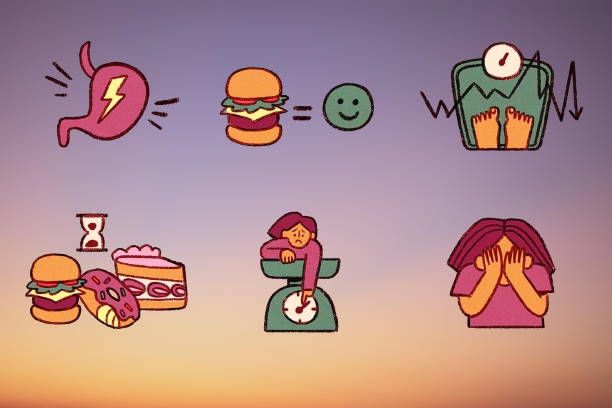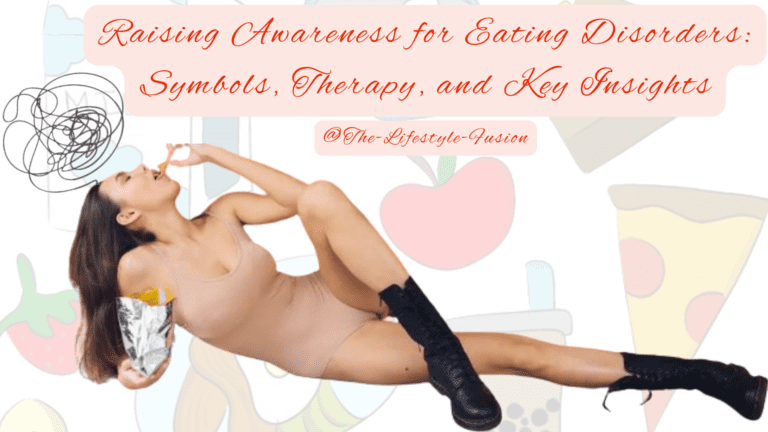Introduction
Raising awareness for eating disorders is crucial to ensure that those affected receive the help and support they need. Eating disorders are complex and serious mental health conditions that affect millions of individuals worldwide. They are characterized by unhealthy eating behaviors that can significantly impact one’s physical and emotional well-being.
In this blog, we will explore various aspects of eating disorders, including symbols associated with them, the role of cognitive behavioral therapy (CBT), the relationship between obesity and eating disorders, the impact of stress, and the importance of early detection through indicator tests. We’ll also discuss hidden eating disorders, acute eating disorders, and the importance of balance in recovery.
The Importance of Awareness for Eating Disorders

Awareness for eating disorders is crucial for multiple reasons. It plays a key role in breaking the stigma associated with these conditions, making it easier for individuals to seek help without fear of judgment.
Increased awareness encourages more people to recognize th signs and symptoms of eating disorders, leading to earlier detection and intervention. Educating the public about these issues promotes understanding and empathy, which can improve support systems for those affected.
By highlighting the importance of awareness, we can foster a more informed and compassionate community, ultimately leading to better treatment outcomes and support for individuals struggling with eating disorders.
The Mediterranean Diet supports mental health through its nutritional harmony, offering a balanced approach that promotes cognitive well-being and emotional stability. By understanding and integrating these dietary aspects, we can significantly enhance both prevention and recovery efforts. This balanced nutrition fosters early intervention and provides better support for those affected, contributing to overall mental health and resilience.
Eating Disorder Symbol

One of the most recognizable symbols for eating disorder awareness is the purple ribbon. This symbol stands for hope, support, and solidarity for those affected by eating disorders. It is widely used in campaigns, events, and advocacy efforts to raise awareness and demonstrate compassion for individuals struggling with these conditions.
The purple ribbon serves as a visual representation of the collective effort to support and uplift those battling eating disorders. Additionally, the National Eating Disorders Association (NEDA) has its own symbol—a stylized heart with an eating utensil.
This emblem represents the love, care, and understanding that should be extended to individuals facing eating disorders. Both symbols play a crucial role in highlighting the importance of awareness, encouraging open dialogue, and fostering a supportive community for those affected by these challenging conditions. They help to create a more informed and empathetic society.
Cognitive Behavioral Therapy for Eating Disorders

Cognitive Behavioral Therapy (CBT) is widely recognized as one of the most effective treatments for eating disorders. This therapy centers on identifying and altering negative thought patterns and behaviors that contribute to disordered eating.
CBT helps individuals understand how distorted thinking influences their eating habits and body image. By challenging these harmful thoughts, CBT encourages the development of healthier eating practices and promotes improved self-esteem.
The therapy also equips individuals with practical coping strategies to manage triggers and stressors that may lead to disordered eating. Through structured sessions, patients learn to replace maladaptive behaviors with constructive ones, supporting long-term recovery.
CBT’s focus on both cognitive and behavioral aspects makes it a comprehensive approach to addressing eating disorders. Overall, it fosters a more balanced and positive relationship with food and oneself.
How CBT Works

CBT for eating disorders typically involves several key components:
- Education: Patients learn about the effects of their eating disorder on their body and mind.
- Cognitive Restructuring: Therapists work with patients to identify and challenge distorted thinking patterns.
- Behavioral Interventions: Patients develop healthier eating behaviors and coping strategies.
- Relapse Prevention: Therapists help patients create a plan to maintain their progress and prevent relapse.
Studies have shown that Cognitive Behavioral Therapy (CBT) helps reframe thinking by making you aware of and adjusting negative patterns, particularly during heightened anxiety or panic. By addressing both cognitive and behavioral aspects, CBT provides a comprehensive approach to eating disorders, fostering a more balanced and positive relationship with food and oneself.
Cognitive Behavioral Therapy (CBT) helps reframe thinking by making you aware of and adjusting negative patterns, particularly during heightened anxiety or panic. By addressing both cognitive and behavioral aspects, CBT provides a comprehensive approach to eating disorders, fostering a more balanced and positive relationship with food and oneself.
The therapy’s structured approach enables patients to manage their symptoms and work towards recovery. Overall, CBT is a well-established, evidence-based treatment for these conditions.
Is Obesity An Eating Disorder?

The relationship between obesity and eating disorders is complex and multifaceted. While obesity itself is not classified as an eating disorder, it can be both a cause and a consequence of disordered eating behaviors.
Obesity often results from unhealthy eating patterns, and individuals with binge-eating disorder may struggle with obesity due to frequent episodes of consuming large quantities of food in a short period without purging. This type of disordered eating involves a lack of control during binges, leading to weight gain and, eventually, obesity.
Conversely, obesity can also contribute to the development of eating disorders, as individuals may engage in disordered eating behaviors in response to societal pressures and stigma related to their weight. This interplay creates a cycle where disordered eating exacerbates obesity, and obesity can further perpetuate disordered eating patterns.
Addressing both conditions simultaneously is crucial for effective treatment and long-term recovery. Understanding this relationship helps in developing comprehensive treatment plans that address the physical, emotional, and behavioral aspects of both obesity and eating disorders.
Understanding the Link

Obesity and eating disorders share several common risk factors, including:
- Genetics: Certain genetic factors can predispose individuals to both obesity and eating disorders.
- Psychological Factors: Low self-esteem, depression, and anxiety are common in both conditions.
- Environmental Factors: Exposure to dieting culture and societal pressure to maintain a certain body type can contribute to the development of both obesity and eating disorders.
It’s crucial to recognize that not everyone with obesity has an eating disorder, and not all individuals with eating disorders are obese. Each condition has distinct characteristics and requires a specific treatment approach.
Addressing the unique needs of each condition ensures more effective and tailored care. Accurate diagnosis and individualized treatment plans are essential for optimal outcomes.
Disordered Eating is Often Hidden

Disordered eating is often hidden from view, making it difficult for friends, family, and healthcare professionals to detect. Individuals with disordered eating frequently go to great lengths to conceal their behaviors, employing tactics like eating in secret or lying about their food intake.
They may avoid eating in social settings or meticulously plan their meals to maintain control without drawing attention. This secrecy can extend to manipulating weight records or disguising physical symptoms.
Such behaviors complicate the detection and diagnosis of eating disorders, as they often mask the true extent of the issue. The hidden nature of these disorders requires heightened awareness and vigilance from those around the individual.
Also, it underscores the importance of creating a supportive environment where open communication and trust can encourage disclosure and prompt help. Early detection relies on recognizing subtle signs and understanding the methods individuals use to hide their struggles.
Signs of Hidden Eating Disorders

Some common signs of hidden eating disorders include:
- Preoccupation with Food: Constantly thinking about food, calories, or dieting.
- Secretive Eating: Eating in private to avoid scrutiny.
- Changes in Weight: Significant weight fluctuations without a clear cause.
- Emotional Changes: Increased irritability, depression, or anxiety.
Recognizing the signs of eating disorders is crucial for early intervention and effective treatment. Identifying symptoms early allows for timely medical and psychological support, which is essential for preventing the condition from worsening.
Early detection facilitates a swift response, enabling healthcare professionals to address both physical and emotional issues before they escalate. Prompt recognition also helps in initiating appropriate care strategies tailored to the individual’s needs.
This proactive approach significantly enhances the likelihood of recovery and reduces the risk of long-term complications. Early intervention not only improves outcomes but also supports better overall well-being and quality of life.
Acute Eating Disorder

An acute eating disorder is marked by a sudden and severe onset of disordered eating behaviors, which can quickly escalate into a critical condition. These cases often involve extreme symptoms such as rapid weight loss, severe malnutrition, or intense bingeing and purging episodes.
Due to the immediate risks to physical health, including potential life-threatening complications, urgent medical intervention is necessary. This typically involves hospitalization to stabilize the individual’s condition and address any acute health issues.
Alongside medical treatment, psychological support is crucial to manage the underlying mental health aspects of the disorder. Comprehensive care, including nutritional rehabilitation and intensive therapy, is required to address both the symptoms and the root causes.
Early and effective treatment can prevent further deterioration and improve the chances of recovery. This integrated approach is essential for managing the acute phase and setting the stage for long-term treatment and support.
Addressing Acute Eating Disorders

Treatment for acute eating disorders typically involves:
- Medical Stabilization: Addressing any immediate health concerns, such as malnutrition or electrolyte imbalances.
- Psychological Support: Providing intensive therapy to address the underlying causes and behaviors.
- Nutritional Rehabilitation: Helping individuals develop healthier eating habits and restore a balanced diet.
Early and comprehensive treatment is crucial for preventing long-term health issues related to eating disorders. Timely intervention addresses both physical and psychological aspects, improving recovery outcomes. It helps avoid complications and supports sustained well-being.
Stress, Eating Disorders, and Depression

Stress is a significant factor that can contribute to the development and exacerbation of eating disorders and depression. When individuals experience high levels of stress, they may turn to unhealthy eating behaviors, such as emotional eating, restrictive eating, or binge eating, as coping mechanisms. These behaviors can lead to or worsen eating disorders.
Concurrently, the physical and emotional toll of an eating disorder can increase stress and trigger depressive symptoms. Depression often co-occurs with eating disorders, with each condition intensifying the other. This bidirectional relationship creates a vicious cycle where stress fuels disordered eating, and disordered eating amplifies stress and depression.
Effective treatment must address all three components—therapy, stress management techniques, and support networks—to break the cycle and promote recovery. Therapy, including Cognitive Behavioral Therapy (CBT), helps reframe negative thought patterns.
Stress management techniques, such as Mindfulness-Based Stress Reduction (MBSR), play a crucial role in reducing stress by enhancing awareness and fostering relaxation. Support networks provide essential encouragement and understanding. Together, these elements work to manage the interconnected conditions of eating disorders and related mental health issues, leading to more effective and holistic recovery.
How Stress Affects Eating Behaviors

When individuals experience high levels of stress, they may turn to food for comfort or control. This can lead to unhealthy eating behaviors, such as:
- Emotional Eating: Consuming food in response to emotional distress rather than physical hunger.
- Restrictive Eating: Limiting food intake as a way to regain a sense of control.
- Binge Eating: Eating large amounts of food in a short period to cope with stress.
The Impact of Mental Stress
Mental stress or depression often partially or wholly related with eating disorders. Individuals with depression may have a distorted body image and low self-esteem, making them more vulnerable to developing an eating disorder.
Conversely, those with eating disorders may develop depression due to the physical and emotional toll of their condition.
The Role of Eating Disorder Indicator Tests

Early detection of eating disorders is critical for effective treatment and recovery. Eating disorder indicator tests are valuable tools that help identify individuals at risk and prompt them to seek professional help.
These tests often include self-report questionnaires that assess eating habits, body image, and emotional well-being. Clinical interviews conducted by healthcare professionals delve deeper into the individual’s history and symptoms.
Physical assessments evaluate the impact of disordered eating on the body, such as weight changes and nutritional deficiencies. Early detection allows for timely intervention, which significantly improves the chances of recovery. It also helps in tailoring treatment plans to the specific needs of the individual.
By identifying warning signs early, these tests facilitate access to appropriate care and support. Ultimately, indicator tests play a crucial role in preventing the escalation of eating disorders and promoting better health outcomes.
Types of Indicator Tests

There are several types of eating disorder indicator tests, including:
- Self-Report Questionnaires: These are commonly used in clinical settings and online assessments. They ask about eating habits, body image, and emotional well-being.
- Clinical Interviews: Conducted by healthcare professionals, these interviews delve deeper into the individual’s history and symptoms.
- Physical Assessments: Medical evaluations to assess the physical impact of disordered eating, such as weight, blood pressure, and nutritional deficiencies.
Importance of Early Detection
Early detection through indicator tests can lead to timely intervention, which is crucial for recovery. The earlier an eating disorder is identified, the more effective the treatment is likely to be.
Indicator tests can also help differentiate between different types of eating disorders, ensuring that individuals receive the most appropriate care.
Balancing Eating Disorder Recovery

Achieving balance in eating disorder recovery is essential for long-term success. It involves developing a healthy relationship with food, body image, and emotional well-being. This balance is not only about eating a nutritious diet but also about understanding and addressing the psychological aspects of the disorder.
Patients must work on self-acceptance and positive body image, which are often significant challenges. Therapy plays a crucial role in this process, helping individuals to reframe their thoughts and behaviors.
Support from family and friends is also vital, providing encouragement and understanding. Incorporating mindfulness practices can help manage stress and keep individuals grounded in the present moment.
Regular check-ins with healthcare professionals ensure that recovery is on track. Building a strong support network and accessing resources, such as support groups, can provide additional layers of support.
Ultimately, achieving balance means integrating these elements into a cohesive plan that promotes holistic well-being and sustained recovery.
Strategies for Balance

- Nutritional Guidance: Working with a dietitian to create a balanced meal plan that meets nutritional needs.
- Therapeutic Support: Continuing therapy to address any lingering emotional or psychological issues.
- Mindfulness Practices: Incorporating mindfulness techniques to help manage stress and stay present.
- Support Systems: Building a strong network of friends, family, and support groups to provide encouragement and accountability.
Conclusion
Raising awareness for eating disorders is vital to combating these serious mental health conditions. Symbols like the purple ribbon and organizations like NEDA play a crucial role in promoting understanding and support. Cognitive Behavioral Therapy (CBT) remains a cornerstone of treatment, offering hope for recovery. While obesity is not an eating disorder, it shares many risk factors with these conditions, highlighting the need for a nuanced approach to treatment.
Disordered eating is often hidden, making it important to recognize subtle signs and provide support. Acute eating disorders require urgent intervention, while managing stress and depression is crucial in recovery. Eating disorder indicator tests are essential tools for early detection and intervention, paving the way for better outcomes and healthier lives.
By continuing to educate ourselves and others about eating disorders, we can create a more supportive and compassionate environment for those affected, ultimately leading to better treatment, recovery, and prevention efforts.






